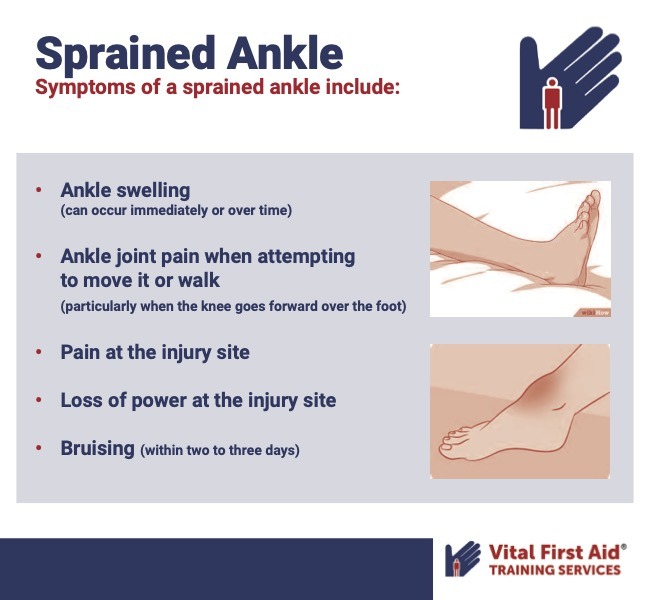The Vital Facts
- Around 230,000 Australians see a GP for an ankle sprain each year
- Ankle sprains are the most common injury in sport
Many of us have experienced or witnessed injuries, particularly sporting injuries such as sprains, strains, fractures, and dislocations. These types of injuries can result from sporting injuries, such as a sudden twist or jolt, a fall, or a motor vehicle accident, amongst other things.
Jump to:
- What is a sprain?
- What happens to your ankle when you sprain it?
- Symptoms of a sprained ankle
- Treating a sprained ankle
- When to seek medical assistance
- Other possible diagnoses
What Is A Sprain?
A sprain is a soft tissue injury involving stretching or tearing ligaments (the tough fibrous tissue bands that connect bones to other bones) away from a joint.
Sprains are often caused by an injury, and a sprained ankle is one of the most common sporting injuries.
When a sprain occurs, your joint moves in an unnatural way and the ligament gets stretched and pulled.
What Happens To Your Ankle When You Sprain It?
The ankle joint has three bones that are precisely shaped to interlock and give stability. There is connective tissue called ligaments, which reinforce the joint and help hold the bones in place and together. These ligaments restrict unnatural movement of the joint.
An overextension or twist can result in these supporting ligaments stretching and tearing, which is referred to as a sprain. Sprains are a common injury, especially in sports where fast-twitch muscle fiber activity is common such as basketball, football, etc.
Some people are more prone to sprains than others. People who have sprained their ligaments repeatedly in the past may develop chronic instability in the ligaments impacted.
Symptoms Of A Sprained Ankle
Symptoms of a sprained ankle include:
- Ankle swelling (can occur immediately or over time)
- Ankle joint pain when attempting to move it or walk (particularly when the knee goes forward over the foot)
- Pain at the injury site
- Loss of power at the injury site
- Bruising (within two to three days)

Treating A Sprained Ankle
To heal a sprained ankle, you need to reduce the swelling and ease the pain. Not all ankle sprains heal on their own, and some may even need surgery. An ankle sprain that doesn’t heal properly can lead to recurring sprains and instability.
Regardless of the severity of the sprain, it is recommended to make an appointment with your GP to ensure you haven’t done any more serious damage.
If you’ve injured your ankle and are experiencing moderate to severe pain, it is recommended to call 000 or go to hospital, as it may be fractured. An ankle fracture requires immediate medical attention.
When To Seek Medical Assistance
It’s important to see a doctor if:
- Your ankle is deformed
- Your pain is extreme
- You cannot walk at all or take any weight on the foot
- You cannot move the joint
- There is numbness or redness in the area
- The pain has not improved after a couple of days
Recurring ankle sprains require comprehensive examination and rehabilitation.
Treatment For A Sprained Ankle
Treatment options and outcomes necessary for individuals who have sprained their ankle include:
- Stop your activity
- Rest in a comfortable passion (sitting with support or lying down)
- Apply ice indirectly to the sprain to help reduce pain
- Compression (lightly, with an ankle brace or elastic bandage)
- Elevation
- Seek medical assistance form either a local doctor or hospital
- Pain relief such as Paracetamol, if required
- Use of crutches if required
- Exercises to increase strength and mobility under the guidance of a medical professional
You may decide to see a physiotherapist as part of your treatment. Your physiotherapist will give you specific exercise programs to improve mobility and strengthen muscles and may tape your ankle or suggest an ankle brace. Strengthening and mobility exercises will improve ankle function and expedite your recovery.
Other Possible Diagnoses
All injuries are painful, and ankle sprain symptoms can be similar to a fracture or a strain. It’s important to know what your injury is so you can heal correctly. You may need an x-ray to see if you have broken a bone.
Strains and Sprains
Something has been stretched, partially torn, or completely torn in both a sprain and a strain. The difference between a sprain or a strain lies in which body part has been injured. A sprain is a stretched or torn ligament (connecting bones to joints), whereas a strain is stretched or torn muscle or tendon (connecting muscle to bone).
Sprains and strains are both likely to cause swelling, and sprains may also incur bruising, while strains may incur muscle spasms. You should be able to move the joint (with limited mobility) for both a strain and sprain.
Fractures
A fracture, on the other hand, is when one or more of the three bones in the ankle is cracked or broken. Fracture symptoms can vary, with signs of a fracture potentially including:
- Unable to bear any weight or move the ankle at all
- Bone sticking through the skin
- Cracking sound
- Numbness or tingling
- Misshapen ankle
- Moderate to severe pain (as opposed to mild-moderate pain)
- Pain is directly over your ankle bone (as opposed to the soft part of your ankle in a sprain)
Dislocations
Ankle dislocations are another possibility, often resulting from a sporting injury. Ankle dislocations are a result of trauma and do not happen spontaneously. Dislocations are extremely painful, with the injury resulting in the bone being forced out of position within the joint. It is important to seek medical treatment immediately for a dislocation. Ankle dislocations as an isolated injury are uncommon – there is usually an associated fracture.
Symptoms of an ankle dislocation include:
- Severe pain
- Bruising and swelling
- Unable to bear weight
- A deformed look to the ankle
- Bone poking through the skin
- Difficulty moving the ankle
Learn First Aid For Sprains & Other Injuries With Vital First Aid
For individuals working or volunteering for sporting events, it’s essential that they have the knowledge and skills to confidently apply first aid and respond to a medical emergency until professional medical assistance is available.
Our qualified first aid trainers are highly skilled and experienced, and all students will receive a First Aid Certificate on completion.
To benefit from our range of first aid courses, sign up here.
Courses are available throughout Sydney, Newcastle and the Central Coast.






